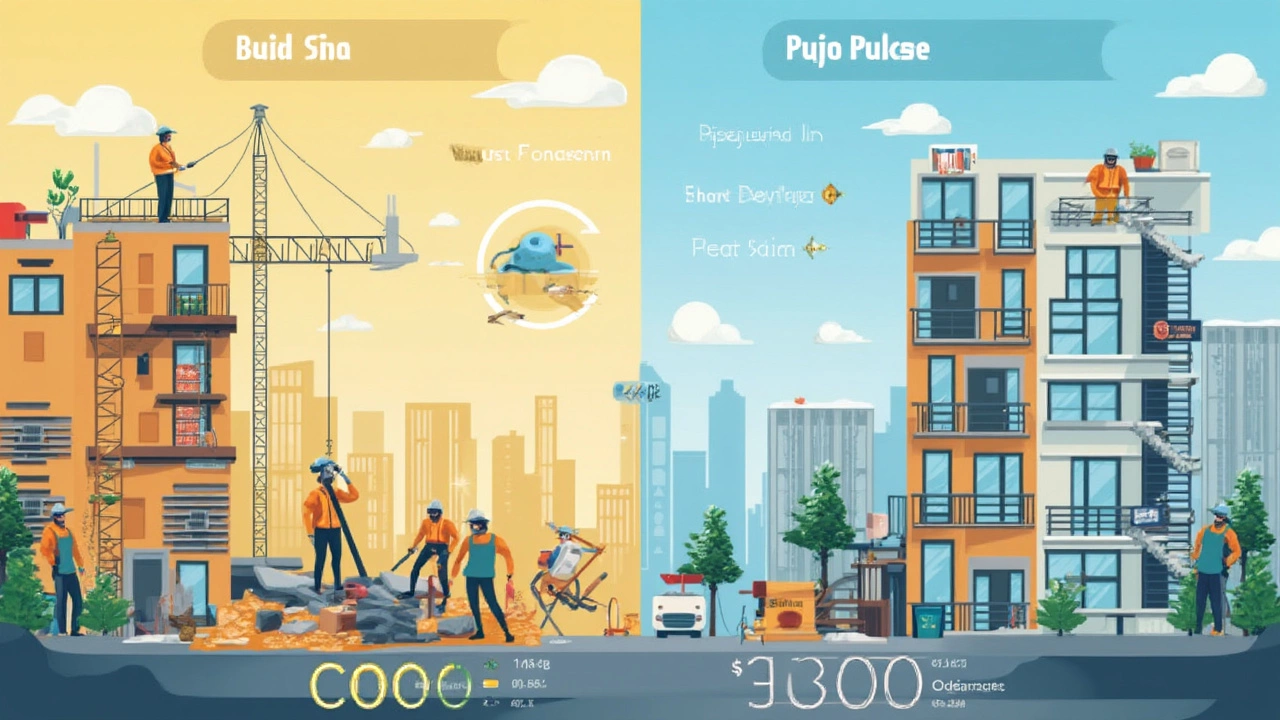So, you've been wondering if it's cheaper to build your own home than to buy one off the market in 2025, huh? Prices are bouncing around like they've had one too many cups of coffee—making it tough to pin down what might actually save you a few dollars.
First off, let's talk trends. The property market in 2025 has been wild. Between material costs and labor, building isn't always the bargain it used to be. Let's not even start on the housing market prices seem to rise quicker than your toddler's tantrums.
Building a home comes with its own set of headaches, but also some financial perks. From energy-efficient features to lower maintenance costs, new builds have their shiny selling points. Meanwhile, buying saves you waiting—with keys in hand the moment you sign, though you might be inheriting someone else's DIY disasters.
Feeling lost? You're not alone, my friend. It’s all about weighing what you value more: time or savings. And hey, maybe there's a way to get the best of both worlds with a savvy blend of building and buying options.
- Current Market Overview
- Cost Breakdown of Building
- Cost Breakdown of Buying
- Tips for Deciding Your Best Option
Current Market Overview
Diving into the property market in 2025 is like trying to ride a roller coaster without a seatbelt—hold on tight, because things are all over the place! With new builds and established homes just a financial hop, skip, and jump from each other, it's important to know what you're getting into.
First, let’s talk about housing prices. They’ve been climbing steadily, making that picturesque bungalow you’ve been eyeing a little less cozy for your wallet. But, believe it or not, new builds are still hanging in the race. Thanks to advances in construction tech and smart designs, building a home today isn't as outrageous as it sounds.
Now, when it comes to construction costs, expect surprises. Material costs, for example, have been on a bit of a roller coaster of their own. Lumber prices, which were through the roof in the past years, have eased, but steel and concrete still add heavy bucks to the overall bill.
And don’t ignore labor costs. Securing skilled workers who can finish even basic tasks without chaos has turned the building game into a small town's most-watched drama. It's the little twists and turns like these that can really rack up the costs, making some folks wonder whether buying might just be less of a headache.
| Aspect | Key Insight |
|---|---|
| Material Costs | Volatile, with lumber stabilizing but steel and concrete high. |
| Labor Availability | Scarce, causing potential project delays. |
| Mortgage Rates | Fluctuating, impacting affordability for both building and buying. |
So, how to make sense of this? Pay close attention to local market reports and trends. You'll get the real lowdown on whether that dream home stays a dream or becomes reality.
Cost Breakdown of Building
Thinking about constructing your dream home? Yeah, there's nothing like picking out every little detail. But before you dive into those blueprints, let’s unpack the costs involved in building a home from scratch.
First up, the biggie: land. In 2025, securing a plot isn’t as easy or cheap as it used to be, especially in popular areas. We’re seeing prices rise about 10% a year in some spots around Auckland. And let's not overlook site preparation costs, which can catch folks off guard. Leveling, soil testing, and surveys might add a few zeros to the budget if the land isn't just right.
Next, there's construction. Labor costs have hopped up, thanks to skilled worker shortages, making builders' fees quite steep nowadays. Speaking of building a home, material prices for essentials like timber and steel are seeing a bump too. Thanks to supply chain disruptions, getting your hands on materials can be a pricey waiting game.
Utilities and permits come into the mix, too. Connecting electricity, water, and sewerage is essential but not always included in your contractor's fee, adding potential headaches and costs you might not initially think about. Plus, the paperwork and permits can accumulate, from council approvals to building consents.
Then, we turn our attention to the finishing touches. Think fixtures, fittings, and little extras. Fancy lights, plush carpets, or designer taps—each choice adds up, and these costs often sneak in when you least expect them.
- Land acquisition and preparation
- Construction and labor
- Materials like timber and steel
- Utilities setup and permits
- Interior and customization costs
The good news? If you're savvy, there are ways to keep costs on a leash. Choosing a builder with a solid reputation can prevent surprise expenses, and going for energy-efficient options might pinch your pocket now but can lead to savings down the road. Plus, building grants or incentives available in New Zealand for new builds might just ease the financial load a bit.
Sure, building isn't always the cheapest route, but its potential benefits could strike the right chord for you if you play your cards right.

Cost Breakdown of Buying
Buying a home seems pretty straightforward, right? Not so fast. There's more than just the price tag you see in those online listings. Let's drill down into what makes up the real cost of buying a home in 2025.
First off, the sticker price. That number often leads the way, but it’s just the tip of the iceberg. You're looking at market prices that have recently seen a hike in many regions. A lot of folks are getting comfortable with paying a premium these days due to limited inventory. The demand might outpace supply, which can mean offering above the asking price just to snag a deal.
Next comes closing costs. These can sneak up on you like a cat in the night. They usually range between 2% to 5% of the purchase price. These cover all the legal bits and bobs like attorney fees, inspection fees, and title insurance. You might also have to fork out for appraisal fees to make sure you're not overpaying for your dream home.
Oh, and don’t forget about the property taxes. These can vary wildly depending on where you put down roots. Check the local tax rates so you don’t get a nasty surprise later on. Budget for them as part of your monthly living costs.
If you're taking out a mortgage, interest rates are another slice of the pie. They're hovering around average levels but keep an eye on fluctuations because every little bit affects monthly payments. Locking in a good rate can save you heaps over the lifespan of your loan.
Then there are the extras. Think of ongoing costs like homeowner’s insurance and potential home repairs. Even the best-looking home can turn into a money pit if you’re not careful, especially with older properties that might look charming but hide a Pandora’s box of maintenance issues.
Here's a little snapshot:
| Component | Typical Cost |
|---|---|
| Closing Costs | 2% - 5% of home price |
| Property Taxes | Varies by location |
| Homeowner's Insurance | Depends on the home type and location |
| Maintenance & Repairs | 1% - 4% annually of home value |
Buying a home is a big decision with lots of moving parts. It's essential to factor in these hidden costs to avoid biting off more than you can chew financially. Doing your homework and crunching the numbers before you buy can keep you from any ugly financial surprises.
Tips for Deciding Your Best Option
Choosing between building and buying isn't exactly as simple as picking out a new pair of sneakers. Let's dive into a few things you should chew over before making that big decision.
First, size up your budget. Calculate not just the price tag of the land or house but think bank accounts later! For new builds, construction costs, permits, and taxes pile up quickly. For buying, consider renovation and repair costs—your dream home may need a little TLC.
Time's definitely a key player here. Building can take anywhere from a few months to over a year. If you're squatting in your in-laws' basement until then, are you sure you're ready for that wait? Buying lets you skip the waiting game and start living your best life stat.
Don't forget about location! Building gives you more flexibility over where you plant those roots—maybe near a great school or your favorite hiking trail. Buying, on the other hand, means working with what's available on the market, which might limit your choices.
Lastly, check out local incentives and grants. Some areas offer sweet deals for home construction, like tax breaks or rebates, especially if you're going green with energy-efficient features. That's some serious dough-saving potential you don't want to skip over.
- Financial Check: Look at all costs involved, not just the sticker price.
- Timeline: Decide how long you're willing (or able) to wait.
- Location Preferences: Consider the perks of choosing your own spot.
- Incentives: Dig into local grants that could cut costs.
Whatever direction you lean, make sure it feels right for your heart and wallet. A little planning now can save you from sneaky surprises down the road.


Write a comment